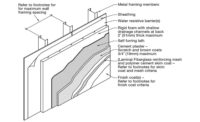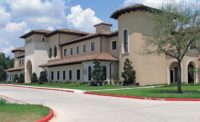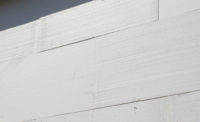The building envelope is the first and least expensive element to address in the design of energy efficient homes and above grade walls are where shortcuts are taken most often. A NAHB-RC study summarized below shows that two-thirds of a typical home’s heat loss is due to above grade walls when combining both conductive and convective heat lost.
Why do above grade walls add up to such heat loss? The nature of light-framed stud wall construction results in a design that is difficult to insulate sufficiently on the inside, and requires bracing from lateral loads, typically on the outside. These two factors have led to prevailing construction techniques that don’t sufficiently weigh building science basics, which are to have a building envelope that controls heat, air and moisture transport.
The House Koozie: A Metaphor for Insulation
What is not complicated is the metaphor of a “House Koozie”—a continuous layer of exterior foam insulation to control the heat exchange between a conditioned space and the exterior. Much like foam koozies we commonly use to keep our hand warm and our beer cold, CI keeps the hot side hot and the cold side cold regardless of climate.
Sure there is commonly used cavity insulation within the walls, but cavity insulation doesn’t insulate at the wall framing. In fact, most wall surfaces are close to 25 percent framing and 75 percent cavity. Some mornings, thermal shots through wall framing can be seen without the aid of an expensive heat-imaging camera.
We already know CI provides energy savings, but what about the rest of the story? In northern climates, (which would include most of the eastern United States in 2014) walls without CI can experience another building science failure commonly known as “Dew Point.” Going back to our metaphor, there is a third function our koozie provides—to keep the beer can from “sweating” all over the coffee table. The moisture in the air on humid days will condense on the outside of the beer can or glass of ice tea.
Inside the Wall
Unfortunately, the same sort of condensation is happening on the inside surface of the wall more than we know because wall cavities are enclosed and not visible. Making things worse, most cavity insulations are high surface area materials that like to absorb moisture and cannot readily dry out due to a lack of air movement within enclosed wall cavities. High levels of moisture during construction combined with fast construction schedules contribute to extreme cavity moisture. The first winter temperature is when problems can surface on the inside surface of the sheathing. The levels of moisture can result in mold and fungi growth (Photo 3) that is unseen but often affects people with allergies living in these homes.
Unfortunately, using 2x6 walls without CI but with higher R-value air permeable cavity insulation only makes the dew point phenomenon worse. Additional cavity R-values means that the inside sheathing face of non-CI walls gets less heat from the conditioned space and will hit the dew point temperature even easier. By regulating the temperature of the wall cavity, “CI” provides exceptional moisture protection performance in residential walls. Increasing stud cavity temperature is critical to managing the potential for condensation within conventional light framed wall designs. The significant R-value of exterior wall insulation increases stud cavity temperature, which creates a distinct moisture protection advantage over other non-insulated sheathing materials.
A Full Package of Benefits: The Upgraded Envelope
Builders know the importance of using a high performance wall assembly and are seeking products that provide many key functions: water resistant barrier, air barrier, strength and R-values. Most insulated foam sheathings are excellent water control layers (WRBs). In addition, insulated foam sheathings have been shown to improve air barrier performance, or convective heat loss, compared to wood structural sheathing used alone due to its unique ability to “gasket” to framing. The added protection CI provides to sealed wall cavities and its ability to provide a means to avoid damaging mold growth is forcing builders everywhere to consider the full package of benefits continuously insulated exterior walls has to offer.
For more on “Why CI,” check out the Foam Sheathing Committee Web site (fsc.americanchemistry.com) for an immense amount of useful information and construction details.











Report Abusive Comment